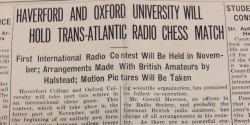Awhile back I saw a post on social media announcing the 75th anniversary of college radio. Although I’m excited any time someone writes about college radio history, I was also troubled, because I know that college radio is much older. Being quite fascinated with the early days of college radio, I’m aware of licensed college radio stations that were broadcasting in the 1920s. Organizations like the College and University Association of Broadcasting Stations were already active by 1926 (the New York Times listed nearly 30 member stations at the time).
It’s actually not surprising to see random dates given as the “start of college radio,” as I’ve run across numerous accounts of stations claiming to have been first across a wide span of decades. We have scant records of stations from the 1920s, so most college radio history is unknown.
Adding to the confusion is Louis M. Bloch’s book The Gas Pipe Networks: A History of College Radio 1936-1946. Published in 1980, the book is a wonderful record of the early days of campus-only carrier current broadcasting. Although it’s a first-person account of the start of carrier current radio at Brown University in 1936 and of the subsequent growth of carrier current stations on other campuses, the book is often interpreted as documenting the earliest days of college radio. It doesn’t help that in the preface Bloch writes, “This book tells the story of my involvement in college radio, affectionately called ‘The Gas Pipe Networks’. Also related in this book is the story of college radio’s founders, George Abraham and David Borst, both engineers.”
It’s easy to understand why Brown University often refers to itself as having the first college radio station (rudimentary dorm radio networks started there in 1936) and Wesleyan University (WES launched in 1939) refers to itself as having the 2nd, as these are the two stations described in The Gas Pipe Networks as being college radio’s pioneering stations. As more and more stations were built, the Intercollegiate Broadcasting System formed in order to help support their growing numbers, share programming, and acquire advertisers. In February 1940, the Intercollegiate Broadcasting System hosted its first convention at Brown University.
I don’t want to underestimate the importance of the launch of carrier current campus radio in the 1930s and 1940s, as this was a key component of the growth of college radio. As with all college radio history, the early days of carrier current broadcasting have not been adequately documented and aren’t widely known.
With that said, I’m celebrating the more than 95-year history of college radio by sharing some clues about the earliest college radio stations from the 1920s. I’ve spent a lot of time researching college radio at Haverford College, where the first student-run station, WABQ AM, debuted in 1923. As I mentioned last week, I’ll be giving a talk about the history of radio at Haverford on Tuesday, February 23rd at Haverford College. You can also tune in to this week’s Radio Survivor Podcast to hear some tidbits from that history (part two will run next week).
Other licensed college radio stations appeared on the scene even earlier, including WRUC at Union College and WLB at University of Minnesota. As I continue to build the About College Radio page on Radio Survivor, I will keep adding college radio tidbits about some of those early stations.
I’m also helping to collect information on college radio archives as part of my work on the Library of Congress’ Radio Preservation Task Force, whose first conference is taking place from February 25th to 27th in the Washington, D.C. area. As always, drop me a note if you have college radio history to share.
A version of this article appeared in the January 14, 2015 edition of the Radio Survivor Bulletin. You can subscribe to our weekly Bulletin here.



